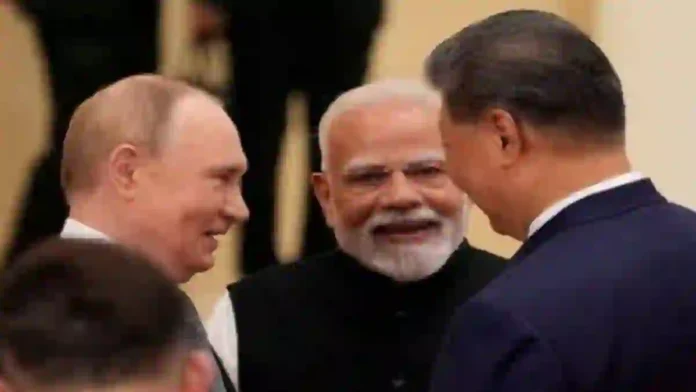Russian Foreign Minister Sergei Lavrov said that Russia, India, and China recognise their shared interests across multiple sectors and are actively developing closer partnerships. His remarks followed the Shanghai Cooperation Organisation (SCO) summit in Tianjin last week, where a symbolic “triple handshake” between Prime Minister Narendra Modi, President Vladimir Putin, and President Xi Jinping drew global attention.
Lavrov described the gesture as proof that the three major powers—each representing ancient civilizations—are aligning on areas of mutual interest.
Read- DRDO And L&T To Test-Fire Indigenous ATGM From Zorawar Light Tank To Validate Its Weapon System
The moment also sparked reactions worldwide, with U.S. President Donald Trump expressing concern on social media about India and Russia deepening ties with China.
Geopolitical Implications of India-Russia-China Alignment at the SCO Summit
The symbolic “triple handshake” between Prime Minister Narendra Modi, Vladimir Putin, and Xi Jinping at the Tianjin SCO summit underscores evolving dynamics in Eurasian geopolitics. While largely symbolic, the gesture indicates an openness among the three powers to emphasise convergence at a time of global realignment.
Strategic Significance
Multipolar Assertion: India, Russia, and China together represent nearly half of humanity and a major share of the global economy. Their visible coordination at a multilateral forum signals a greater push for a multipolar order, challenging U.S.-led alignments.
SCO As A Platform: The SCO is emerging as a key stage for Eurasian security, connectivity, and economic discussions. The show of unity reflects the grouping’s attempt to project internal cohesion despite existing bilateral frictions, especially India-China tensions.
Read- Pakistan When Karma Comes Calling
Read- India’s Next Indigenous Aircraft Carrier Likely To Be Nuclear Powered
Shared Interests
Energy & Connectivity: Russia’s role as a supplier, China’s financing power, and India’s market potential create a natural triangle in energy, infrastructure corridors, and regional integration.
Technology & Finance: Alternatives to Western-dominated financial systems (such as de-dollarisation, local currency trade) are increasingly common ground among the three.
Security Cooperation: Counterterrorism, regional stability in Afghanistan, and security of Central Asian corridors remain areas of alignment.
Constraints & Contradictions
India-China Border Disputes: Despite symbolic gestures, territorial tensions remain the biggest obstacle for genuine trilateral cooperation.
Russia’s China Tilt: Moscow’s growing economic dependence on Beijing creates friction with New Delhi, which traditionally values strategic autonomy.
India’s Western Partnerships: India’s participation in the Quad and growing defence-industrial ties with the U.S. set limits on how far this trilateral understanding can deepen.
Implications
For The West: The U.S. views any such overt gestures with unease, as seen in President Trump’s reaction, highlighting concerns that multipolar coalitions may undercut Western influence.
For The Global South: This alignment strengthens narratives of alternative power centres and frameworks for regional cooperation not dominated by the West.
For India: The balancing act continues—leveraging relations with Russia and engaging China in multilateral formats, while maintaining hedges through deeper U.S. and Indo-Pacific engagements.
This trilateral symbolism, while not removing structural frictions, indicates that India, Russia, and China are aware of the need for managed competition and limited cooperation where interests converge.
Agencies




